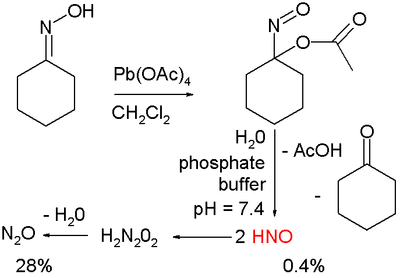Nitroxyl
 | |
| Names | |
|---|---|
| IUPAC name
Azanone | |
| Systematic IUPAC name
Oxidanimine | |
| Other names
Hydrogen oxonitrate(I) Nitronous oxide | |
| Identifiers | |
| 14332-28-6 | |
| 3D model (Jmol) | Interactive image |
| ChEMBL | ChEMBL1200689 |
| ChemSpider | 920 |
| MeSH | Nitroxyl |
| PubChem | 945 |
| |
| |
| Properties | |
| HNO | |
| Molar mass | 31.01 g·mol−1 |
| log P | 0.74 |
| Structure | |
| Digonal | |
| Dihedral | |
| Thermochemistry | |
| 33.88 J K−1 mol−1 | |
| Std molar entropy (S |
220.91 J K−1 mol−1 |
| Except where otherwise noted, data are given for materials in their standard state (at 25 °C [77 °F], 100 kPa). | |
| Infobox references | |
Nitroxyl (common name) or azanone (IUPAC name)[1] is the chemical compound HNO. It is well known in the gas phase.[2] In aqueous solution it acts as an acid with the conjugate base NO−, (pKa = 11.4).[3] NO− is the reduced form of nitric oxide (NO) and is isoelectronic with dioxygen. Nitroxyl can be formed as a reaction intermediate.
Nitroxyl is very reactive towards nucleophiles (especially thiols) and quickly dimerizes to hyponitrous acid, H2N2O2, which is then dehydrated to nitrous oxide N2O. Therefore, HNO is generally prepared in situ for example with the compounds such as Angeli’s salt (Na2N2O3) and Piloty’s acid (PhSO2NHOH) when it is needed.
Nitroxyl donors, known as nitroso compounds, show potential in the treatment of heart failure and ongoing research is focused on finding new molecules for this task. In one study [4] such donor is prepared by organic oxidation of cyclohexanone oxime with lead tetraacetate to form 1-nitrosocyclohexyl acetate:
This compound can be hydrolyzed under basic conditions in a phosphate buffer to HNO, acetic acid and cyclohexanone.
Other studies that have been conducted on HNO precursors include those from Nagasawa et al.[5] in which Piloty's acid is derivatized and produces HNO upon thermal decomposition. Other notable studies on the production of HNO come from Toscano et al.[6] in which cycloadducts of acyl nitroso species (which are known to decompose via hydrolysis to HNO and acyl acid) are synthesized. Upon photolysis these compounds release the acyl nitroso species which then further decomposes.
More information can be found in the book The Chemistry and Biology of Nitroxyl.[7]
References
- ↑ Doctorovich, F.; Bikiel, D.; Pellegrino, J.; Suárez, S. A.; Larsen, A.; Martí, M. A. (2011). "Nitroxyl (azanone) trapping by metalloporphyrins". Coordination Chemistry Reviews. 255 (23–24): 2764–2784. doi:10.1016/j.ccr.2011.04.012.
- ↑ Greenwood, Norman N.; Earnshaw, Alan (1997). Chemistry of the Elements (2nd ed.). Butterworth-Heinemann. ISBN 0-08-037941-9.
- ↑ Wiberg, Egon; Holleman, Arnold Frederick (2001). Inorganic Chemistry. Elsevier. ISBN 0-12-352651-5.
- ↑ Sha, Xin; Isbell, T. Scott; Patel, Rakesh P.; Day, Cynthia S.; King, S. Bruce (2006). "Hydrolysis of Acyloxy Nitroso Compounds Yields Nitroxyl (HNO)". J. Am. Chem. Soc. (Article). 128 (30): 9687–9692. doi:10.1021/ja062365a.
- ↑ Nagasawa, H. T.; Kawle, S. P.; Elberling, J. A.; DeMaster, E. G.; Fukuto, J. M. J. "Prodrugs of Nitroxyl as Potential Aldehyde Dehydrogenase Inhibitors vis-a-vis Vascular Smooth Muscle Relaxants". Med. Chem. 38: 1865–1871. doi:10.1021/jm00011a005.
- ↑ Cohen, A. D.; Zeng, B.-B.; King, S. B.; Toscano, J. P. (2003). "Direct observation of an acyl nitroso species in solution by time-resolved IR spectrocopy". J. Am. Chem. Soc. 125: 1444–1445. doi:10.1021/ja028978e.
- ↑ Doctorovich, Farmer, Martí (2016). 1. The Chemistry and Biology of Nitroxyl (HNO). Elsevier. ISBN 978-0-12-800934-5.

